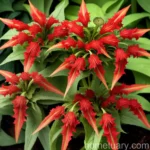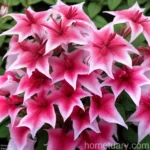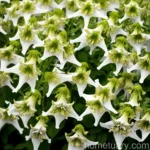# The Cardinal Flower (Lobelia cardinalis)
Plants are an essential part of our environment, providing us with oxygen, food, and medicine, while also offering beauty and tranquility. In this blog post, we will explore the fascinating world of the cardinal flower (Lobelia cardinalis), a stunning and ecologically important plant that has captured the interest of gardeners, botanists, and nature enthusiasts alike.
What is the Cardinal Flower?
The cardinal flower, scientifically known as Lobelia cardinalis, is a striking herbaceous perennial plant that belongs to the family Campanulaceae. It is native to the Americas, where it can be found growing in a variety of habitats, from wetlands and riverbanks to woodlands and meadows.
The plant is named after its vivid red flowers, which resemble the bright red robes worn by Roman Catholic cardinals. The cardinal flower’s tubular blossoms attract a wide range of pollinators, particularly hummingbirds, making it a valuable addition to gardens and natural landscapes.
The cardinal flower has been cherished for centuries for its ornamental beauty, ecological significance, and potential medicinal properties. Let’s delve into the key aspects of this remarkable plant, including its cultural importance, uses, preferred growing conditions, and propagation techniques.
Key Takeaways – Cardinal Flower (Lobelia cardinalis)
Before we delve deeper into the cardinal flower’s characteristics and care requirements, let’s summarize some of the key takeaways about this fascinating plant:
- Scientific Name: Lobelia cardinalis
- Family: Campanulaceae
- Habitat: Wetlands, riverbanks, woodlands, meadows
- Features: Vivid red tubular flowers, attracts hummingbirds and other pollinators
- Uses: Ornamental gardening, landscaping, wildlife habitat restoration
- Cultural Significance: Valued for its beauty and ecological importance
- Growth Habit: Herbaceous perennial
- Attracts: Hummingbirds, bees, butterflies
Now that we have an overview of the cardinal flower, let’s explore its cultural significance, uses, and optimal growing conditions in more detail.
Culture
The cardinal flower holds significant cultural and ecological importance, particularly within the contexts of gardening, landscaping, and wildlife conservation. Understanding its cultural value provides insights into its diverse uses and its role in supporting ecosystems.
Uses
The cardinal flower offers a range of uses, making it a versatile and valuable plant in various settings. Some of its primary uses include:
-
Ornamental Gardening: It is a popular choice for gardeners looking to add a splash of vibrant red color to their landscapes. The cardinal flower’s striking blooms make it a standout feature in flower beds, borders, and naturalistic plantings.
-
Wildlife Habitat Enhancement: Its nectar-rich flowers attract pollinators such as hummingbirds, bees, and butterflies, making it an essential component in efforts to support local wildlife populations.
-
Wetland Restoration: Due to its natural propensity for wetland habitats, the cardinal flower is a valuable addition to wetland restoration projects, aiding in the establishment of diverse and resilient ecosystems.
-
Medicinal Potential: Some indigenous cultures have used parts of the cardinal flower for medicinal purposes, although caution is advised due to its toxic properties.
Water
The cardinal flower thrives in moist to wet soil conditions, often found growing along riverbanks, in wet meadows, and near the edges of ponds and marshes. When cultivating cardinal flowers, it’s important to ensure that they receive an adequate water supply, particularly during dry periods.
It is essential to maintain consistently moist soil, as the plant is adapted to its natural wetland habitats. Periodic irrigation may be necessary during dry spells, especially for cardinal flower plantings in drier garden settings.
Sunlight
While the cardinal flower has a preference for moist soil, it also thrives in areas with ample sunlight. It typically flourishes in full sun to partial shade, although it tends to produce more robust blooms when exposed to direct sunlight. In shadier conditions, the plant may still grow and flower, but the blooms may not be as profuse.
To achieve the best results with cardinal flowers, aim to plant them in locations where they receive a good balance of sunlight and moisture. This could be in a garden bed that receives full morning sun and partial shade in the afternoon, or in a wetland area with dappled sunlight filtering through nearby trees.
Fertilizer
Cardinal flowers are not heavy feeders and generally do not require excessive fertilization. If the soil is naturally rich in organic matter, it may provide adequate nutrients for the plant’s growth and flowering. However, if the soil is lacking in fertility, incorporating a balanced, slow-release fertilizer during the growing season can help support the cardinal flower’s vigor.
When using fertilizers, it is crucial to follow the product’s instructions and avoid over-fertilizing, as excessive nutrients can lead to lush foliage at the expense of flower production. A soil test can provide valuable insights into the soil’s nutrient levels, guiding the appropriate use of fertilizers to meet the cardinal flower’s needs.
Soil
The cardinal flower is adaptable to various soil types, as long as they are consistently moist and well-drained. It thrives in fertile, humus-rich soils that retain moisture without becoming waterlogged. In its natural habitats, the plant commonly grows in soils with a slightly acidic to neutral pH, ranging from 5.5 to 7.0.
Amending the soil with organic matter, such as compost or well-rotted manure, can enhance its water retention capacity and fertility, creating an ideal growing medium for cardinal flowers. Additionally, incorporating a layer of mulch around the base of the plants helps to maintain soil moisture and regulate temperatures, fostering healthy growth.
Pruning
Pruning practices for the cardinal flower primarily focus on maintaining plant health, controlling excess growth, and shaping the plant to enhance its visual appeal. Here are some key considerations for pruning cardinal flowers:
-
Deadheading: Removing spent flowers promotes continued blooming and prevents the plant from expending energy on seed production. This can prolong the cardinal flower’s flowering season, ensuring a vibrant display for an extended period.
-
Thinning: Periodically thinning out overcrowded stems and foliage can improve air circulation and reduce the risk of disease and pest problems. It also assists in maintaining an attractive plant form and prevents the cardinal flower from becoming excessively dense.
-
Late-season Pruning: As the growing season comes to a close, cutting back the spent flower stalks and any damaged or decaying foliage helps tidy up the plant and prevents the accumulation of debris that could harbor pathogens over winter.
Propagation
Propagating the cardinal flower can be achieved through several methods, allowing for the expansion of its presence in gardens and natural areas. Here are the primary propagation techniques for cardinal flowers:
-
Seed Propagation: Collecting ripe seeds from the plant’s flowers and sowing them in suitable growing medium can yield new cardinal flower seedlings. When sowing seeds, providing a period of cold stratification enhances germination rates, mimicking the natural conditions required for seed viability.
-
Division: Dividing mature cardinal flower clumps during the early spring allows for the creation of new plantings. Each division should consist of several vigorous shoots with healthy root systems, ensuring their capacity to establish themselves in new locations.
-
Root Cuttings: Taking cuttings of the cardinal flower’s underground rhizomes and rooting them in a suitable medium presents another viable propagation method. This approach can help generate new plants from established cardinal flower specimens, contributing to their propagation and distribution.
Container Popularity
While the cardinal flower is commonly grown in garden beds and naturalized settings, its striking beauty and adaptability have also made it a popular choice for container gardening. When grown in containers, the cardinal flower can brighten decks, patios, and balconies, offering a captivating display of color and attracting beneficial wildlife to urban and suburban environments.
Container cultivation of the cardinal flower requires attention to its specific needs, including soil moisture, sunlight exposure, and maintenance practices. Selecting suitable container sizes, appropriate potting mixes, and diligent care can result in successful growth and flowering of cardinal flowers in containers.
Container Common Diseases
Container-grown cardinal flowers may be susceptible to certain diseases and environmental stressors, which can impede their growth and vitality. Understanding these potential issues and employing preventive measures is crucial for maintaining healthy cardinal flower plantings in containers.
Some common diseases and stress factors that can affect containerized cardinal flowers include:
-
Root Rot: Excessively moist or poorly drained container soils can lead to root rot, causing the plant to exhibit wilting, yellowing foliage, and stunted growth. Using well-draining potting mixes and avoiding overwatering helps prevent this issue.
-
Powdery Mildew: This fungal disease can develop on the cardinal flower’s foliage, appearing as powdery white patches that can diminish its visual appeal. Providing good air circulation around container plants and avoiding overhead watering can reduce the risk of powdery mildew.
-
Nutrient Deficiencies: Containerized plants may experience nutrient deficiencies due to the depletion of nutrients in the potting mix over time. Regularly applying a balanced, slow-release fertilizer or periodic liquid feedings can help maintain optimal nutrient levels for the cardinal flower.
Disease Diagnosis
Diagnosing diseases in container-grown cardinal flowers involves attentive observation of the plant’s overall appearance, foliage condition, and growth patterns. Recognizing the symptoms of common diseases enables timely intervention and the implementation of appropriate management strategies.
When assessing the health of containerized cardinal flowers, watch for the following signs of potential diseases and stress factors:
-
Foliage Discoloration: Yellowing, browning, or mottling of the leaves can indicate nutrient deficiencies, disease infections, or physiological disorders.
-
Stunted Growth: Reduced growth, lack of vigor, or poor flowering can be indicators of underlying issues such as inadequate nutrition, root constraints, or disease pressure.
-
Abnormal Spots or Lesions: The presence of unusual spots, lesions, or abnormal growths on the plant’s foliage could signal disease infections that require prompt attention and management.
If disease symptoms are identified, it is recommended to consult with local agricultural extension services, plant health specialists, or experienced horticulturists to obtain accurate diagnoses and tailored recommendations for addressing the specific issues affecting container-grown cardinal flowers.
Common Pests
While cardinal flowers are generally resistant to most pests, particularly due to their toxic nature, certain insects may still pose occasional challenges to their health and appearance. Being aware of common pests that can affect the cardinal flower allows for proactive pest management and safeguards the plant’s well-being.
Potential pests that may impact the cardinal flower include:
-
Aphids: These small, soft-bodied insects may feed on the plant’s sap, causing distortion of new growth and the development of sticky honeydew on the foliage. Natural predators, such as ladybugs and lacewings, can help control aphid populations.
-
Spider Mites: In dry and warm conditions, spider mites can infest cardinal flower plants, leading to stippled and discolored foliage. Regularly misting the plants and maintaining adequate humidity levels can deter spider mites.
-
Slugs and Snails: These mollusks may consume the cardinal flower’s tender foliage and flowers, particularly in moist and shaded container settings. Applying organic slug and snail control measures, such as barriers and traps, can protect the plants from damage.
Vigilant monitoring of containerized cardinal flowers and the early detection of pest infestations enable the timely implementation of targeted pest control methods, minimizing potential harm and preserving the plants’ aesthetic and ecological value.
Botanist’s Tips
As plant scientists and enthusiasts, it is important to understand and appreciate the cardinal flower’s distinct characteristics, ecological significance, and cultivation requirements. Here are some helpful tips for effectively growing and stewarding cardinal flowers:
-
Selecting Planting Locations: When introducing cardinal flowers to a garden or natural area, carefully choose sites with adequate moisture and sunlight, considering the plant’s natural habitat preferences.
-
Companion Planting: Pairing cardinal flowers with complementary species that share similar growing requirements, such as moisture levels and light exposure, can enhance the overall aesthetics and ecological value of the plantings.
-
Species Diversity: Integrating cardinal flowers into diverse plant communities promotes resilience and supports a broader range of pollinators, contributing to the overall health and balance of local ecosystems.
-
Naturalized Landscapes: Incorporating cardinal flowers into naturalized landscapes and restoration projects can aid in creating visually appealing and ecologically functional habitats that benefit wildlife and native flora.
-
Observation and Monitoring: Regularly observing the cardinal flower’s growth, development, and interactions with wildlife provides valuable insights into its performance and ecological contributions.
-
Responsible Cultivation: Being mindful of the cardinal flower’s potential invasiveness in certain regions and adhering to ethical cultivation practices helps prevent the plant from negatively impacting native ecosystems.
Fun Facts
As we explore the fascinating world of the cardinal flower, here are some intriguing and fun facts about this captivating plant:
-
The cardinal flower’s bright red blossoms serve as a visual beacon for pollinators, particularly hummingbirds, which are drawn to the tubular flowers’ nectar sources.
-
While the cardinal flower is recognized for its fiery red blooms, certain cultivars and varieties exhibit variations in flower color, including shades of pink and purple.
-
It is believed that the name “lobelia” honors the Flemish botanist Matthias de l’Obel, while the species name “cardinalis” pays homage to the vivid red robes worn by Roman Catholic cardinals, which resemble the plant’s blossoms.
-
The cardinal flower’s association with water and wetland habitats has inspired its use in rain gardens, water features, and ecological restoration projects, where it contributes to natural flood mitigation and water filtration.
-
Indigenous cultures have historically used certain parts of the cardinal flower for medicinal purposes, although caution should be exercised due to its toxic properties and potential health risks.
Links to External Resources
For further exploration of cardinal flowers, including their ecological roles, cultivation techniques, and horticultural significance, consider delving into the following resources:
- The Native Plant Trust – Cardinal Flower (Lobelia cardinalis)
- The Xerces Society for Invertebrate Conservation – Nectar Plants for North American Pollinators: Cardinal Flower
- North Carolina State Extension – Growing Cardinal Flower in the Garden
- Missouri Botanical Garden – Lobelia cardinalis
- University of Florida IFAS Extension – Cardinal Flower for Wetland Restoration
By engaging with these resources, you can deepen your understanding of the cardinal flower and its role in supporting biodiversity, enhancing landscapes, and captivating the imagination of plant enthusiasts worldwide.
Conclusion
The cardinal flower (Lobelia cardinalis) stands as a symbol of natural beauty, ecological vitality, and horticultural inspiration. Its vibrant red blossoms, preference for moist habitats, and role in supporting wildlife make it a focal point in gardens, natural areas, and conservation efforts.
As we continue to appreciate and steward the cardinal flower, let us uphold its cultural and ecological significance, embracing its capacity to enrich our lives and contribute to the resilience of our shared natural environments.
From its stunning displays in wetland gardens to its allure in urban landscapes, the cardinal flower beckons us to celebrate the wonders of the plant world and nurture the connections between humans, wildlife, and the living landscapes we all call home.
Remember, the cardinal flower’s brilliance extends beyond its captivating appearance—it resonates with the vibrant rhythms of nature, inspiring us to cultivate beauty and biodiversity in our surroundings.
So, whether you’re tending to cardinal flowers in a garden, beholding their elegance in the wild, or simply marveling at their ecological role, may the cardinal flower continue to ignite our curiosity and kindle our reverence for the botanical wonders that grace our world.
As we conclude our exploration of the cardinal flower, let its radiant blooms and ecological charisma guide us toward a deeper appreciation of nature’s artistry and the enduring connections that bind us to the plant kingdom.
This blog post is brought to you by the Plant Science Society, a community dedicated to promoting the understanding and appreciation of plants in our world. Connect with us for more insights, resources, and conversations about the captivating realm of plants.
Disclaimer: The information provided in this blog post is for educational and informational purposes and does not constitute professional botanical or medical advice. Always consult with qualified professionals for specific plant care guidance and health-related concerns.
yaml
title: "The Cardinal Flower (Lobelia cardinalis)"
author: "Plant Science Society"
date: "October 30, 2022"
keywords:
- Cardinal flower plant
- Lobelia cardinalis
- Cardinal flower care
- Growing cardinal flower
- Lobelia cardinalis plant
- Cardinal flower gardening
- Cardinal flower information
- Cardinal flower habitat
- Cardinal flower characteristics
- Lobelia cardinalis flower
- Cardinal flower facts
- Cardinal flower landscape
- Cardinal flower perennial
- Cardinal flower native
- Cardinal flower cultivars
- Lobelia cardinalis varieties
- Cardinal flower blooming
- Cardinal flower garden
- Cardinal flower uses
- Cardinal flower medicinal
- Benefits of cardinal flower
- Cardinal flower for pollinators
- Cardinal flower in wetlands
- How to plant cardinal flower
- Cardinal flower seeds
- Cardinal flower propagation
- Cardinal flower for landscaping
- Cardinal flower for wildlife
- Cardinal flower attracting hummingbirds
- Cardinal flower for shade gardens
- Cardinal flower companion plants
- Cardinal flower for rain gardens
- Cardinal flower in containers
- Cardinal flower for butterflies
- Cardinal flower for ponds
- Cardinal flower for water gardens
- Cardinal flower growing tips
- Cardinal flower in full sun
- Cardinal flower in partial shade
- Cardinal flower color variations
- Cardinal flower maintenance
- Cardinal flower soil requirements
- Cardinal flower in native plant garden
- Cardinal flower for erosion control
- Cardinal flower as a cut flower
- Cardinal flower in rock gardens
- Cardinal flower and wetland restoration
- Cardinal flower for vertical gardens
- Cardinal flower in borders
- Cardinal flower for attracting bees















